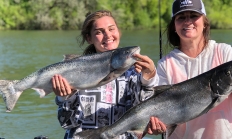
Search myodfw.com

Turkey hunters should be aware of all state hunting regulations, but pay special attention to these things – all of which are listed in the table of contents of the Oregon Game Bird Hunting Regulations: Licensing and tags Shooting hours Legal hunting methods Turkey hunting opportunities The Game Bird Regulations are available both online and in print, both are organized in the same way. Licensing and tags In Oregon, all hunters older than 12 years need a hunting license. Kids 12-17 years old can buy a special, value-priced youth license that also includes fishing and shellfishing. In addition to a

Burns Pond fish die-off caused by natural “turnover” event; ODFW plans to re-stock trout this fall
HINES, Ore. – ODFW biologists confirmed that a natural mixing event, or "turnover," likely caused the death of stocked rainbow trout recently observed at Burns Gravel Pond on Hwy 78. The pond is located two miles east of Burns, Ore., on Hwy 78 on property owned by ODFW. The pond's two basins are…
New pilot program for limited entry parking at Sauvie Island Beaches Free pass required summer weekends and holidays starting July 4
SAUVIE ISLAND WILDIFE AREA, Ore.— To manage ongoing traffic and parking problems at Sauvie Island Wildlife Area's beaches, ODFW is introducing a new limited-entry parking pilot program. Starting July 4, vehicles will need a free Sauvie Island Beaches Pass in addition to the Wildlife Area Parking…
Commission adopts limited Umpqua River fall Chinook season
PENDLETON, Ore. ‐ The Fish and Wildlife Commission adopted a limited fall Chinook fishing and retention season on the mainstem Umpqua, Smith, and North Fork Smith rivers after receiving many public comments and hearing testimony from a Douglas County Commissioner, business owners and local anglers…

ODFW invites anglers to recreational bottomfish and Pacific halibut public meetings: Meetings held in Brookings, North Bend, Newport
NEWPORT, Ore. – Oregon Department of Fish and Wildlife staff are hosting in person meetings Oct. 6, 7, and 8 to discuss the 2026 recreational bottomfish and Pacific halibut seasons with anglers. The Oct. 8 meeting in Newport also offers a virtual option. Meeting information: Oct. 6, Brookings: 5:30…


Regulating harvest, health, and enhancement of wildlife populations Living with wildlife Oregon's permitted wildlife control operators are an individual, business owner, or the business owner's designee charging a fee to control furbearers, unprotected mammals (excluding moles) and western gray squirrels causing damage, creating a public nuisance or posing a public health or safety concern in incorporated city limits and associated urban development areas. They are permitted by ODFW and governed by a set of rules.
General Marine Species bag limit decreases beginning Aug. 18.
NEWPORT, Ore. – The General Marine Species bag limit returns to a four-fish bag limit beginning Monday, Aug. 18. The one-fish sub-bag limit for cabezon and the one-fish sub-bag limit for canary rockfish remain in place, and retention of quillback rockfish and yelloweye rockfish is prohibited. Great…


Additional days for Columbia River salmon fishery announced
CLACKAMAS, Ore. – Fishery managers from Oregon and Washington added more recreational salmon fishing days in the mainstem Columbia River during a joint-state hearing today. The decision came after fishery managers assessed Chinook harvest in the fall season fisheries and considered the current in…



ODFW staff in The Dalles contacted the local trash service provider for approval to modify trashcans. Please do not lock your trashcan or service providers may charge a “locked fee.” Use a carabiner instead. Your trashcan must be strong enough for a bear to stand on. Test yours before modification. If it collapses or the lid bends easily, it will not keep a bear out. Materials and Tools • (1) Heavy-duty Trashcan • (16) #10-24 x 3/8" Nuts • (16) 3/8" Washers • (16) #10-24 x 3/8" Machine Screws • (2) Steel Fixed-Eye Hasps (hinged or flat)* • (1) Wrench


